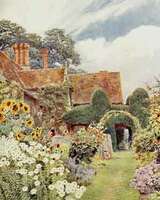The colour scheme begins with the pink of Megasea {Bergenia} ligulata, and with the lower-toned pinks of Fumaria bulbosa {Corydalis spp} and the Dog-tooth Violets (Erythronium). At the back of these are Lent Hellebores of dull red colouring, agreeing charmingly with the colour of the bulbs. A few white Lent Hellebores are at the end; they have turned to greenish white by the time the rather late Scilla amoena is in bloom. Then comes a brilliant patch of pure blue with white�Scilla sibirica and white Hyacinths, followed by the also pure blues of Scilla bifolia and Chionodoxa and the later, more purple blue of Grape Hyacinth. A long drift of white Crocus comes next, in beauty in the border's earliest days; and later, the blue-white of Puschkinia; then again pure blue and white of Chionodoxa and white Hyacinth. Now the colours change to white and yellow and golden foliage, with the bicolour trumpet Daffodil Princeps, and beyond it the stronger yellow of two other small early kinds�Narcissus nanus and the charming little Narcissus minor, quite distinct though so often confounded with nanus in gardens. With these, and in other strips and patches towards the end of the border, are plantings of the Golden Valerian, so useful for its bright yellow foliage quite early in the year. The leaves of the Orange Day-lily are also of a pale yellowish-green colour when they first come up, and are used at the end of the border. These plants of golden and pale foliage are also placed in a further region beyond the plan, and show to great advantage as the eye enfilades the border and reaches the more distant places. Before the end of the bulb-border is reached there is once more a drift of harmonised faint pink colouring of Megasea {Bergenia} and the little Fumaria, (also known as Corydalis bulbosa {Corydalis solida}) with the pale early Pyrenean Daffodil, N. pallidus proecox.
The bulb-flowers are not all in bloom exactly at the same time, but there is enough of the colour intended to give the right effect in each grouping. Standing at the end, just beyond the Dog-tooth Violets, the arrangement and progression of colour is pleasant and interesting, and in some portions vivid; the pure blues in the middle spaces being much enhanced by the yellow flowers and golden foliage that follow.

